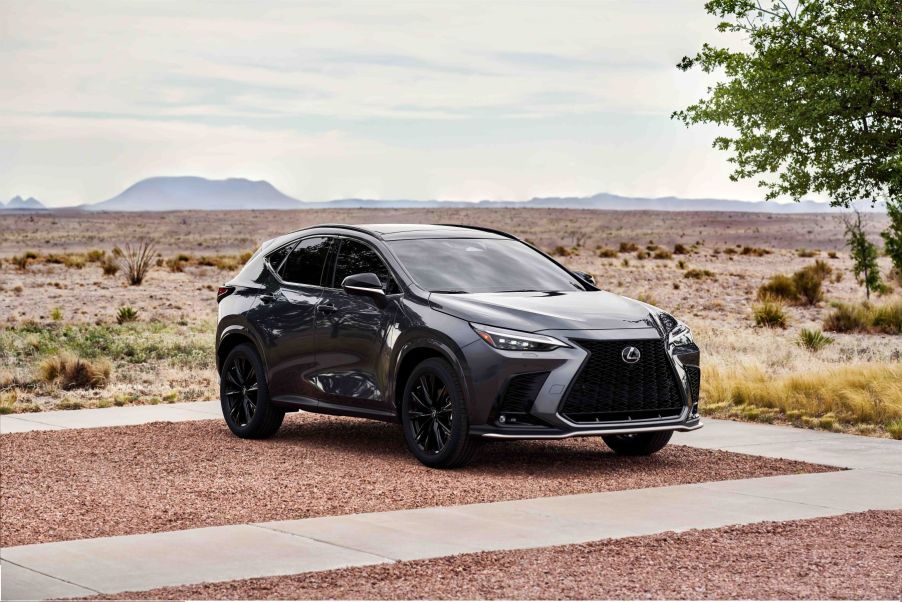
The 2022 Lexus NX Has 1 Advantage Exclusive to Its Gas-Powered Model
When it comes to well-established publications, sometimes it takes a while for the staff to reach a consensus and establish a position. For an organization like Consumer Reports, which has reviewed thousands of products and deploys multiple reviewers for new ones, it’s understandable that achieving consensus can sometimes be an incremental process. Such is the case for the 2022 Lexus NX, which has taken Consumer Reports some time to finish reviewing. In the site’s final analysis, reviewers found many things to like about the new NX. However, most of the positive and negative features are to be found in the hybrid trims rather than conventional internal combustion engine (ICE) ones. Still, there are a couple of positives and negatives that stand out, which are highlighted not only by Consumer Reports but by other publications as well.
A look at the 2022 Lexus NX luxury compact SUV

Consumer Reports reviewers found much to like about the latest Lexus NX model. Among the positives was its fit and finish, which Car and Driver also praised. In its Road Test Report, Consumer Reports noted that while the NX had not undergone any significant exterior design changes, the interior was far plusher than its predecessor. Reviewers highlighted the upscale soft surfaces and engaging controls. Bolsters and cushions made from a leather facsimile provide ample cushioning, which becomes especially helpful during long trips.
However, reviewers were less thrilled with some of the visibility issues stemming from the NX’s small side and rear windows. Additionally, while access to the NX should be easy thanks to its well-positioned seats and tall doors (at least in the front row), the doors themselves have electronic door releases that suffer a delay between activating them and the door opening. Moreover, the releases can be difficult to find at night. Also, access is a bit more difficult in the second row, given smaller doors and awkwardly positioned rear-wheel wells.
Lastly, the gear selector is somewhat confusing and can lead drivers to wind up in Neutral while upshifting or downshifting.
Where the gas-powered NX excels
The gas-powered version has a significant positive over its hybrid counterpart, which prospective buyers should consider seriously if they know they tend to be aggressive behind the wheel. Larger vehicles tend to take longer to brake, and if they are not careful, drivers can cause a collision by failing to hit the brakes quickly enough or misjudging the necessary stopping distance.
The heavier the vehicle, the longer the stopping distance. In this case, the gas-powered Lexus NX is lighter than its hybrid variant. Accordingly, the gas-powered version stops much more quickly, needing 11 feet less braking distance than the hybrid over dry surfaces and 14 feet less over wet surfaces. That’s a big enough difference to stop a collision and perhaps save a life.
Both versions do come with a considerable amount of advanced safety features. Packaged as the Lexus Safety System+ 3.0, drivers have access to adaptive cruise control, lane centering and keeping assistance, and lane departure warning. Both also sport regenerative braking, although the gas-powered version’s braking system is much more polished. With its shorter stopping distance, the gas-powered version has a considerable safety advantage over the hybrid version.
What the Lexus NX Hybrid does well
Despite these flaws, reviewers also noted that the performance and fuel efficiency are respectable for a vehicle in this segment. The gas-powered Lexus NX 350 trim sports a 275-hp turbocharged four-cylinder engine that can hit 60 mph in just 7.2 seconds, though its initial acceleration is bumpy. The four-cylinder is also paired with an eight-speed automatic transmission which downshifts unevenly.
However, the hybrid model is a bit better in these areas. It accelerates smoothly, and its hybrid powertrain, with an electronic continuously variable transmission, shifts gears smoothly. Furthermore, while the gas-powered NX gets a combined 25 mpg in fuel economy (as per Edmunds), the hybrid version gets an impressive 38 mpg. The only caveat? Both require premium fuel.
At 7.6 seconds, the hybrid version does take a bit longer to hit 60 mph. Still, it operates more smoothly and evenly transitions from gas to electric power. Additionally, the slightly heavier weight of the hybrid helps it minimize the bumps occupants feel on rough roads.
There’s an argument to be made for either. If you’re looking for safety, opt for the gas-powered version. But for those looking for fuel efficiency and a smoother ride, the hybrid option delivers.


